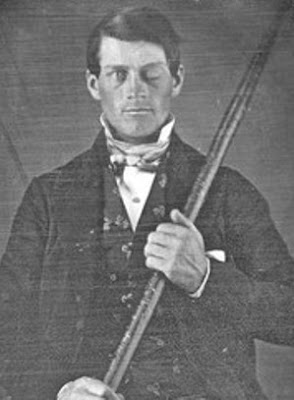 Massachusetts photographers have unearthed the only known image of legendary brain-injury patient Phineas Gage, a daguerreotype showing the former railroad worker sitting in repose and holding the nearly 4-foot-long iron rod that pierced his brain without killing him.
Massachusetts photographers have unearthed the only known image of legendary brain-injury patient Phineas Gage, a daguerreotype showing the former railroad worker sitting in repose and holding the nearly 4-foot-long iron rod that pierced his brain without killing him.Contemporary accounts suggest that Gage's personality was dramatically altered because he was disfigured in the accident, but the new image, to be published online next week in the Journal of the History of the Neurosciences, shows a relatively handsome man -- confirming the belief of most experts that damage to his brain accounted for the changed personality.
Gage was the 25-year-old foreman of a construction gang on Sept. 13, 1848, preparing a railroad bed outside Cavendish, Vt. As usual, he was using a pointed iron rod -- 3 feet, 7 inches long and 13 1/4 pounds -- to tamp gunpowder and sand into a hole drilled in the rock. But on that day, the mixture exploded, sending the rod through his left cheek and out through the top of his head.
It was successfully removed and, to the surprise of physicians, Gage lived 11 more years, dying after a series of increasingly violent convulsions. His story is a showpiece in neurology texts and folklore because of his survival and the abrupt changes in his personality.
The daguerreotype has been in the possession of Jack and Beverly Wilgus for 30 years, although they do not know its origin. They thought it was an image of a whaler holding his harpoon, but whaling experts viewing it online told them it was not. Then an anonymous tipster suggested it was Gage.
Intrigued, the Wilguses compared their image to that of a life mask at Harvard Medical School's Warren Anatomical Museum and found it could be superimposed perfectly, with scars lining up correctly. Apparent writing on the metal rod in the image matches writing on Gage's iron rod, which is also in the Warren Museum. The images can be viewed at http://brightbytes.com/ phineasgage.
thomas.maugh@latimes.com
No comments:
Post a Comment